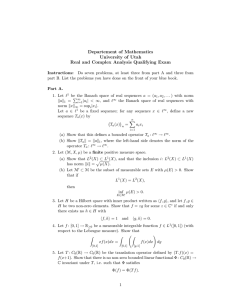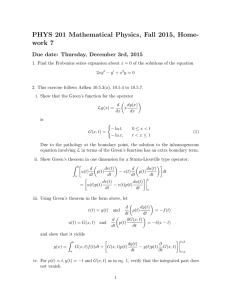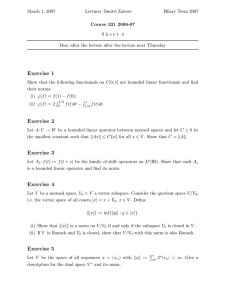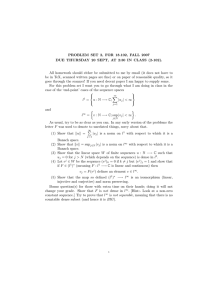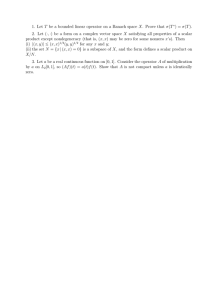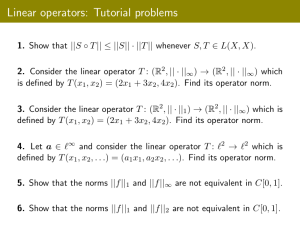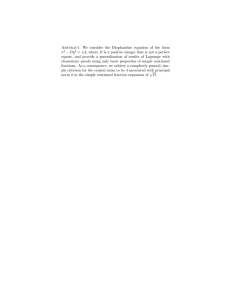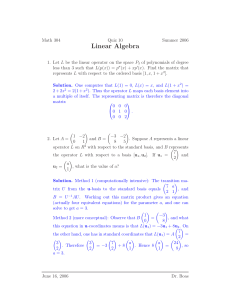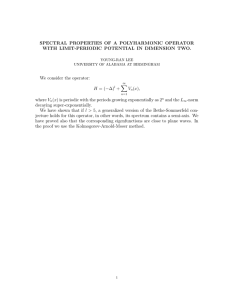Operator Theoretic Approach to the Optimal Two-Disk Problem , Member, IEEE (3)
advertisement
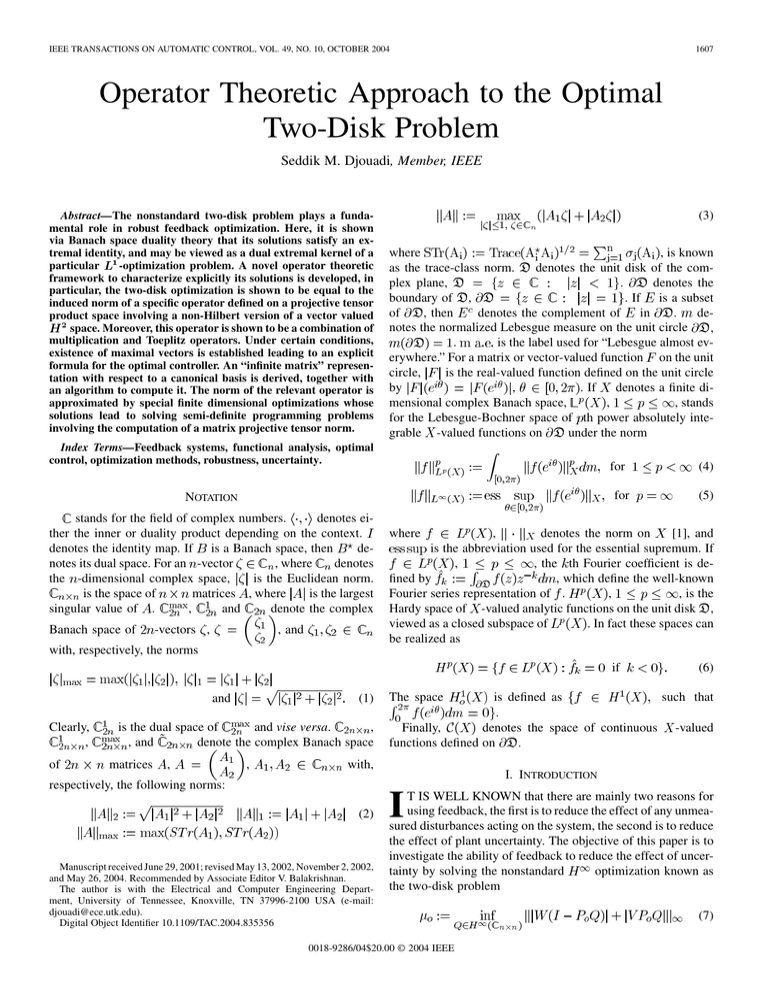
IEEE TRANSACTIONS ON AUTOMATIC CONTROL, VOL. 49, NO. 10, OCTOBER 2004 1607 Operator Theoretic Approach to the Optimal Two-Disk Problem Seddik M. Djouadi, Member, IEEE Abstract—The nonstandard two-disk problem plays a fundamental role in robust feedback optimization. Here, it is shown via Banach space duality theory that its solutions satisfy an extremal identity, and may be viewed as a dual extremal kernel of a particular 1 -optimization problem. A novel operator theoretic framework to characterize explicitly its solutions is developed, in particular, the two-disk optimization is shown to be equal to the induced norm of a specific operator defined on a projective tensor product space involving a non-Hilbert version of a vector valued 2 space. Moreover, this operator is shown to be a combination of multiplication and Toeplitz operators. Under certain conditions, existence of maximal vectors is established leading to an explicit formula for the optimal controller. An “infinite matrix” representation with respect to a canonical basis is derived, together with an algorithm to compute it. The norm of the relevant operator is approximated by special finite dimensional optimizations whose solutions lead to solving semi-definite programming problems involving the computation of a matrix projective tensor norm. (3) , is known where as the trace-class norm. denotes the unit disk of the com. denotes the plex plane, . If is a subset boundary of , , then denotes the complement of in . deof notes the normalized Lebesgue measure on the unit circle , . is the label used for “Lebesgue almost everywhere.” For a matrix or vector-valued function on the unit is the real-valued function defined on the unit circle circle, , . If denotes a finite diby , , stands mensional complex Banach space, for the Lebesgue-Bochner space of th power absolutely inteunder the norm grable -valued functions on Index Terms—Feedback systems, functional analysis, optimal control, optimization methods, robustness, uncertainty. for for NOTATION stands for the field of complex numbers. denotes either the inner or duality product depending on the context. denotes the identity map. If is a Banach space, then de, where denotes notes its dual space. For an -vector is the Euclidean norm. the -dimensional complex space, is the space of matrices , where is the largest , and denote the complex singular value of . Banach space of -vectors , , and (4) (5) where , denotes the norm on [1], and is the abbreviation used for the essential supremum. If , , the th Fourier coefficient is defined by , which define the well-known , , is the Fourier series representation of . Hardy space of -valued analytic functions on the unit disk , . In fact these spaces can viewed as a closed subspace of be realized as with, respectively, the norms if and Clearly, , of (1) is the dual space of and vise versa. , , and denote the complex Banach space matrices , , is defined as such that . denotes the space of continuous -valued Finally, . functions defined on The space with, respectively, the following norms: (2) Manuscript received June 29, 2001; revised May 13, 2002, November 2, 2002, and May 26, 2004. Recommended by Associate Editor V. Balakrishnan. The author is with the Electrical and Computer Engineering Department, University of Tennessee, Knoxville, TN 37996-2100 USA (e-mail: djouadi@ece.utk.edu). Digital Object Identifier 10.1109/TAC.2004.835356 (6) I. INTRODUCTION I T IS WELL KNOWN that there are mainly two reasons for using feedback, the first is to reduce the effect of any unmeasured disturbances acting on the system, the second is to reduce the effect of plant uncertainty. The objective of this paper is to investigate the ability of feedback to reduce the effect of unceroptimization known as tainty by solving the nonstandard the two-disk problem 0018-9286/04$20.00 © 2004 IEEE (7) 1608 where IEEE TRANSACTIONS ON AUTOMATIC CONTROL, VOL. 49, NO. 10, OCTOBER 2004 is a stable plant and are outer weighting functions. It is well known that the problem of worst-case disturbance rejection in a feedback system subject to a pair of uncertain disturbances representing, for example, output and sensor noises, without the simplifying assumption that these are mutually orthogonal reduces to (7) [2], [3]. More importantly, the two-disk problem reflects the fundamental tradeoff between sensitivity , and complementary sensitivity , as outlined in [2], where it was termed the robust performance problem. Other fundamental feedback control problems related to (7) are the optimal robust disturbance attenuation problem (ORDAP) [4]–[7], where an uncertain plant is subject to disturbances at the output, and where the objective is to find a feedback control law which provides the best possible uniform attenuation of output disturbances in spite of uncertainty in the plant model; a plant uncertainty reduction or filtering problem posed by Zames [4, p. 316], where the following question is posed: If a plant lies in some uncertainty set what is the best achievable uncertainty reduction if a feedback control is to be used?, as well as questions of well posedness in feedback optimization studied by Smith [8] and rank one -synthesis. The two-disk optimization problem (7) was considered by, among others, Francis, Owen, and Zames [5]–[7]. In particular, they showed that ORDAP reduces to finding the smallest fixed point of the function shown in (8) at the bottom of the page. In the single-input–single-output (SISO) case, (8) takes the form shown in (9) at the bottom of the page, where the right-hand side (RHS) member is equivalent to the optimization (7). In [5] and [6], it was shown that there is a parametric verproblem which provides sion of the standard two-block an approximate solution based on the standard two-block problem. Zames and Owen showed that such an approximation can be arbitrary poor, and is never better than a factor of , and therefore they stressed the need for an “exact” theory for such problems. The point is that in situations where the , a more fixed-point is sensitive to correct estimation of exact optimization theory is required than that provided by the quadratic two-block problem [9], [10], [7]. Using duality theory they showed that under certain conditions there exists a solution to the two-disk problem, which satisfies an allpass or flatness condition, and is unique in the SISO case. By gridding the frequency domain they proposed a numerical algorithm based on convex programming. However, this algorithm assumes uniform Lipschitz continuity of the problem data (plant and weights), which may be restrictive and has the drawback of solely ap- proximating the optimal solution at a finite number of points. Moreover, duality theory has not fully been exploited, and there has been no closed form solution reported in the literature. To some extent the two-disk problem has also been considered by Holohan and Safonov in the context of optimizing the stability and robustness margins, where part of the duality of the problem was characterized in the SISO case [11]. Recently, Besson and Shenton proposed an approximate graphical ad-hoc solution to the suboptimal version of (7) [12]. The nonstandard nature of the norms involved in the optimizations (7)–(9) make this class of problems intractable by state-space techniques, simply because these norms (as shown later) are induced on certain Banach (non-Hilbert) spaces for which the Parseval Theorem does not hold. Here, it is resorted to developing tools from functional analysis and operator theory parallel to those used during the control theory in the early eighties (see, e.g., emergence of [6], [13], and [14]). In particular, we develop a Banach space duality theory which leads to an exact solution in terms of operator theory. First, it is shown that an extremal measure in the dual is absolutely continuous with respect to the Lebesgue measure, a consequence of this result is that the optimal solution of the two-disk problem satisfies an extremal identity. It is then shown that the optimal solution is a dual extremal function for an space. approximation problem in a particular vector valued Next, it is shown, in particular when flatness holds, that the optimal performance in the two-disk optimization is equal to the induced norm of a special operator. This operator is a Banach space projection of a multiplication operator. The projection is computed explicitly showing that our operator is in fact a combination of multiplication and Toeplitz operators defined on and a subspace of the the projective tensor product of non-Hilbertian (Banach) vector valued space. Under certain conditions, the existence of maximal vectors is proved leading to an explicit formula for the optimal controller in the SISO case. An infinite matrix representation with respect to a canonical basis is given together with general formulas and a recursive algorithm to compute its columns. An approximation of the operator norm by particular convex optimizations subject to a matrix projective tensor norm is also provided, and allows the computation of optimal performance as closely as desired. Finally, it is shown that the computation of the matrix tensor norms reduce to solving a particular semidefinite programming (SDP) with linear matrix inequalities. The latter results in a uniform approximation of the optimal solution unlike the pointwise approximation suggested in [7], [10] under the assumption of (8) (9) DJOUADI: OPERATOR THEORETIC APPROACH TO THE OPTIMAL TWO-DISK PROBLEM uniform Lipschitz continuity of the plant and weights. Although the results here are developed for stable plants, generalization to unstable plants can be made without much effort by working with coprime factorization techniques [15]. In view of the isoon the unit disk and on metric isomorphism between the right-half plane, we will confine ourselves to the unit disk. The results obtained apply to both discrete and continuous time systems. Parts of the results here appeared in [15]–[19]. II. EQUIVALENT DISTANCE PROBLEM IN 1609 III. BANACH SPACE DUALITY STRUCTURE AND EXISTENCE OF OPTIMAL SOLUTIONS denotes the space of Lebesgue measurable, Let and absolutely integrable functions defined on the unit circle with values in under the norm (13) where was defined earlier as the Banach space of (eswith sentially) bounded analytic functions in the unit disk , the norm is given by values in , of , , 2. Let , and the singular values be the quotient space , where (10) such that where . Since is analytic is a subharmonic function there in , then [1], hence, it satisfies the maximum principle and, therefore (11) Letting have inner-outer factorization , and inner–outer factorization , the outer part of , then (7) is equivalent to [10], [9] (12) to the Equation (12) is the shortest distance from subspace and are outer in where [9] and [10], if we assume that of , and (14) the space is obtained by taking complex conjugates. The quotient norm is (15), as shown at the bottom of denotes the coset associated to . It has the page, where is isobeen shown in [21], [22], [9], and [10] that . Since metrically isomorphic to the dual space of may be viewed as a subspace of , and is the preannihilator (or preorthogonal) in , then is isoof metrically isomorphic to the dual space of and we write . Every defines a continon given by uous linear functional , (16) inner. As in then is a closed subspace of , and there exists an , such that outer spectral factor of . Assumption (A1) precludes strictly proper plants, but as in the standard theory, our theory can be extended to them by modifying (see, e.g., [20], [9], and [15]). Moreover, has the following equivalent representation [10], , where , , , so that , Lebesgue almost everywhere ), that is, is inner. This notation should not be confused ( with that for rational functions in . Banach space duality theory is a very important tool in solving optimization problems in normed linear spaces, in particular, the so-called duality product plays a role analogous to the inner product in Hilbert space. In Section III, we give a similar duality structure to [9], [10] which will prove to be more useful for our purpose. where space of . Let be the sub- defined by (17) where denotes the direct sum of two subspaces, is the identity map, and (18) The following Lemma characterizes the preannihilator (or preorthogonal) of . is the preannihilator of in . Lemma 1: Proof: Since is the preannihilator of , the Lemma follows from Lemma 1 in [10], [7], and [3]. From a standard result in Banach space duality theory relating the distance from a vector to a subspace and an extremal (15) 1610 IEEE TRANSACTIONS ON AUTOMATIC CONTROL, VOL. 49, NO. 10, OCTOBER 2004 functional in the predual [23, Th. 2, p. 121], we deduce the following theorem, which asserts the existence of at least one optimal (controller) . Theorem 1: Under assumption (A1), that is, , , there exist at least one optimal such that is given by the space The dual space of of -valued functions of bounded variations on the norm [21], [9], [10], [3] under (22) , and denotes the sum of the total where of all entries of and . Let variations on be the space of -valued functions which are continuous on the closure of the unit disk and analytic in . is known as the disk algebra. The annihilator of is completely described by the vector-valued version of the F. and M. Riesz Theorem [25], which yields (19) denotes the coset norm in . where In general, the supremum on the left-hand side of (19) is not . The best we can say at this point achieved by any is that, it follows by the Bishop–Phelps Theorem [24], that the for which the supremum in set of functions . However, if we (19) is attained is norm dense in assume is continuous on the unit circle and where (20) i.e., when the open unit disk analyticity constraint ), is removed, (in the scalar case ( ), then the optimal solution is flat [9], [10], [7], and the supremum in question is always achieved. This motivates the following section, where an alignment condition and an extremal expression are shown to characterize the optimal solution. Note that assumption (A2) is weaker than a similar assumption in [10], [7], and [9]. IV. ABSOLUTE CONTINUITY AND EXISTENCE OF AN EXTREMAL IDENTITY FOR THE OPTIMUM (23) The dual space of norm is then given by [26], , under the quotient . Next define the subspace . It folis lows from Lemma 3 [10], [3] that the annihilator of given by (24), as shown at the bottom of the page, where . In the following lemma, we establish that the distance from the to the subspace is the same as vector function to . Lemma 2: Under assumptions (A1) and (A2), the following holds: (25) (26) A. Alignment in the Dual Recall that denote the space of continuous functions on with values in . If we set (21) It turns out that under assumptions (A1) and (A2), the maximum in (26) is achieved by a measure absolutely continuous with respect to the Lebesgue measure. It will then follow by the F. and M. Riesz Theorem that the supremum in (19) is in fact achieved . in (24) DJOUADI: OPERATOR THEORETIC APPROACH TO THE OPTIMAL TWO-DISK PROBLEM Lemma 3: Under assumptions (A1) and (A2), we have 1611 . The optimal performance is then a dual extremal function for the approximation problem . , Proof: “Only if” by assumption , and such that where (27) where denotes the coset norm in . Proof: See the Appendix. Lemma 3 implies that under mild assumptions the optimal solution is flat or allpass. It follows also from the proof that the optimal solutions in the dual are aligned. (31) but the integrand B. Dual Extremal Property and Extremal Identity for the Optimum -spaces of scalar valued A well-known fact in the theory of contains a representative functions is that every coset in of the least possible coset norm [27], [28], [26]. More precisely, , consider the linear functional on given a kernel defined by . Knowing that , find a kernel function , such that , and . A dual extremal function is a function , such that, [29], [27], [26]. We will show that these remarkable properties hold , and are inherited by . The opfor can then be intertimal solution preted as the dual extremal function of an optimization problem . in Lemma 4: [16], [15], [19] , there exists a) Given such that (28) b) Given there exists such that (29) is then an extremal kernel or function for . Proof: See the Appendix. Combining Lemmas 3 and 4, we obtain the following theorem which looks familiar in the theory of extremal problems [26]. Theorem 2: Under assumptions (A1) and (A2), , , is an extremal kernel for , and is optimal if and only if (30) integrating implies equality must hold throughout, and (30) holds. This, combined with flatness, implies (32) “If” suppose that (30) holds, integrating it yields hence, equality must hold throughout and is then optimal. Remark 1: Theorem 2 shows that if the convex programming method of [7] and [10] is to be used, the search in the predual which is convex can be restricted to functions which , , (or satisfy , , in the scalar case), moreover, expression (30) can be used as a test for optimality . The RHS of (30) shows that the optimal primal and for dual solutions are “pointwise” aligned in the dual. Note that is not constant, ( ), and are nonzero, in case ), and under assumptions (A1), (A2), , ( , That is at each frequency the dual extremal function , (at least in the scalar . From the case), is an extreme point of the unit ball of flatness condition the RHS of expression (30) is equal almost everywhere to , and points to a tradeoff between the optimal nominal sensitivity represented by , and the optimal nominal complementary sensitivity at each frequency . Since (30) is equal to , it also shows how the weighting functions affect the optimal solution at each frequency. A novel operator theoretic framework to characterize explicitly the solutions to the two-disk problem is developed next. 1612 IEEE TRANSACTIONS ON AUTOMATIC CONTROL, VOL. 49, NO. 10, OCTOBER 2004 V. OPERATOR THEORETIC SOLUTION TO THE TWO-DISK PROBLEM First, introduce a key multiplication operator acting on parand spaces which are not Hilbert. ticular vector valued As pointed out previously, the induced norm of this multiplication operator is equal to the norm involved in the two-disk, and clearly shows that the non-Hilbertian nature of the vector valued and preventing using state–space or time domain techniques to solve this problem. However, these spaces essentially capture the geometry of the problem. Proof: See the Appendix. This proposition shows that these spaces although Banach (non-Hilbertian) are not only reflexive, but also isomorphic to and , respecthe standard Hilbert spaces tively. Moreover, their norms are equivalent. This will allow us to bring some Hilbert space structure into the problem. In the next section, we characterize the optimal solution in terms of a particular operator. VI. EXACT OPERATOR THEORETIC SOLUTION A. Key Multiplication Operator For the remainder of this paper, we will assume that (A1) and (A2) hold. is the complex space of Lebesgue inRecall that -valued functions defined on the unit circle , tegrable under the norm A. Optimal Performance for (33) Note that is not given by any Hilbert space is not a Hilbert space, but is innorm, so that , where deed isomorphic to the Hilbert space is the standard -dimensional Euclidean space. Let , the multiplication operator associated with , and mapping the standard Lebesgue into is denoted by . More precisely space It is clear that the identity map from the Hardy space onto the standard Hilbert space is isomorphic, since these spaces are topologically identical and their norms are equivalent. be the orthogonal projection on the closed Let subspace of , where is understood to be the orthogonal , . complement of Next, define the bounded linear projection as follows: (34) In the next proposition, we show that the operator induced norm is equal to , and in fact it suffices to work in the standard Hardy space . , then Proposition 1: Let 1) (37) where is the usual composition operation. It is clear from the definition of , and the properties of the orthogonal projection that every vector function can be decomposed uniquely as the sum of two vector functions as follows: where (35) 2) (36) Proof: See the Appendix. is finite dimensional, then the dual space of Note that is clearly given by the Banach space [21]. is reflexive. That is It follows that (38) are orthogonal in the sense that . Also, by uniqueness, note that Since the orthogonal projection gives the best approxiby functions in the subspace mation of elements of in the -norm. The projection operator plays a similar role as but for approximations in -norm by elements of . the Now, define the following key bounded linear operator: and , by (39) Define the following continuous bilinear transformation: Recall that ( ) is the closed sub( ) consisting of space of ( )-bounded pairs of analytic functions in the unit disk. In the next proposition, their dual spaces are characterized. and be defined as Proposition 2: Let before, then the following statements hold. 1) . . 2) Hence, and are reflexive Banach spaces. (40) (41) Then, the norm of is given by (42) DJOUADI: OPERATOR THEORETIC APPROACH TO THE OPTIMAL TWO-DISK PROBLEM The bilinear map may be linearized by invoking a projective tensor product space [30]. To see this, define a bounded linear operator on the projective tensor product , by . The projective norm of is defined as shown in the first equation at the , for bottom of the page. More explicitely, letting , , may be written as , in which case (43) A useful property of the projective tensor norm is that it is finitely generated [30], that is, the search in (43) can be restricted and to finite dimensional subspaces of . This fact will be exploited in Section VI-D to derive . The operator plays a central role in an SDP to compute finding an explicit solution to our problem through the following theorem which quantifies optimal performance. Theorem 3: Let be the optimal performance index defined by (7), then under assumptions (A1) and (A2), the following hold. i) is equal to the induced norm of , namely 1613 operators are defined on the standard Hilbert spaces (or suband , and where a multiplication by a cerspaces of) tain unitary operator transform the problem to a one block problem. The difference here is in the definition of the nonHilbertian norm of the range space of , which precludes any transformation to one block problem by pre- or postmultiplication by unitary operators. The existence of a maximal vector for the operator under the previous conditions, implies that a well-known Hankel–Toeplitz operator, which solves the stanproblem, achieves its norm on its discrete dard two-block spectrum for (possibly) infinite-dimensional systems [15]. This settles an open question in [32] and [33]. The existence and computation of maximal vectors, although difficult, is important and lead to the exact computation of the optimal controller as shown in Section VI-B for the SISO case. be arbitrary but fixed, there Proof of Theorem 3: Let , , and exists , , such that (46) and has the form However, It follows then , . , thus (44) ii) There exist maximal vectors for , i.e., -norm 1, and , , or putting , then of such that (45) Remark 2: The operator may be viewed as an analog to the Sarason operator [31], and Young’s operator [13]. In parproblem, where these ticular, for the standard two-block since . Note that (47)–(49), as shown at the bottom of the page, hold true. Since is arbitrary, we get (50), as shown at the bottom of the page. The last equality follows from Theorem 1. where and (47) therefore (48) (49) (50) 1614 IEEE TRANSACTIONS ON AUTOMATIC CONTROL, VOL. 49, NO. 10, OCTOBER 2004 Now, we would like to prove the reverse inequality. Note that (51) , similarly and has norm 1. The member on the left-hand side of (53) is equal to (54)–(55), as shown at is the orthogonal projecthe bottom of the page, where to . In fact, tion from . is the left multiplication operator by and has norm , acting from to By Lemmas 3 and 4 and Theorem 2, there exists , with having , and denotes the duality -norm 1, and such that product in (52) By the proof of Theorem 2, , ; and there exists , , such that However, . Moreover, then , since for some , i.e., , and . ; see the first equation shown at Hence, , the bottom of the page. Noting that . , since , so . Therefore, . Likewise, . Therefore, . Now, let denote the identity matrix, then (53) Exploiting an idea in [34], the subspace consisting of functions each of whose columns belongs to can be identified with the tensor , and will henceforth be denoted so. Likewise . We have , , and (56) (57) . Expressions Hence, , and equality in (55) (50), (52), and (55) imply that must hold inferring existence of maximal vectors. The orthogonal projection plays a crucial role in solving problem, our problem as well as the standard two-block e.g., mixed sensitivity problem. Thus, it is important to compute it explicitly, hence the following theorem. be the orthogonal projection from Theorem 4: Let to , then (58) is the standard Riesz projection, i.e., if where has Fourier coefficient , , then and has Fourier coefficients such that , and , Remark 3: As noted previously, the projection not only twosolves our problem, but also the standard quadratic as acting on the Hilbert space block problem by viewing , and without having to rely on unitary transformations to transform the problem to an equivalent one block problem (see, e.g., [32] and [33].) The same remark applies to problem (when ) by viewing as the standard acting on instead (see, e.g., [35]). (54) (55) DJOUADI: OPERATOR THEORETIC APPROACH TO THE OPTIMAL TWO-DISK PROBLEM Proof of Theorem 4: For , let us compute 1615 Hence, equality must hold throughout, in which case it is posso as to satisfy sible to choose the optimal , Remark 4: For SISO systems ( ), is a scalar function, , and by uniqueness of the optimal solution, we can obtain a formula for the optimum (64) (59) is indeed a projection. Clearly, the adjoint of , although defined on different itself, so that is spaces, is equal to an orthogonal projection. Next, we show that the null space of , . then Let , since , then and, therefore, . Hence, . Conversely, let , then so thus , so and, therefore, It follows from [23, Th. 1, p. 155] that . (60) The following Corollary follows then from Theorems 3 and 4, and provides an explicit solution to the two-disk problem. is given exCorollary 1: The optimal performance index plicitly by the following expression for some , , and , : (61) Next, the optimal controller for the two-disk problem is characterized explicitly. which determines through we get uniquely. Multiplying and dividing , hence, , The optimal con, where , troller achieves the optimal robust performance. For the general case (MIMO systems) the optimal controller is in fact highly nonunique, and a more involved procedure is required in order to compute it. We need sufficiently many independent directions to determine the whole symbol . A good starting point are [34], [36], and [37]. The norm of the operator gives the optimal performance and controller. It is therefore important to develop an algorithm to compute it. This motivates the next section. C. Computation of the Operator Norm In this section, we show how it is possible to compute the and hence the optimal performance norm of the operator , has a power index . First, note that every , for some . series expansion Therefore, , ; ; form , where , is the usual a basis for . To determine a representation of with canonical basis of , ; ; respect to the basis it suffices to study the action of on each element of the for a fixed . We have then for basis say, for example, , , where is the th column of . In the representation of , the th column will be the representation of with respect to the basis , ; ; of B. Optimal Controller Theorem 1 implies that there exists a vector function such that . Hence, we can interpret (62) Moreover by Proposition 1, may be viewed as a acting from into multiplication operator such that . Equivmay be viewed as an operator acting from alently, into , the projectve tensor product . We have by Theorem 4 (63) , for each , as the matrix function whose columns are projections of the columns of onto the subspace . With this in mind, the action of on is then determined by . Therefore, with respect to the canonical basis , has the following representation: (65) Each column in (65) is the image of a basis vector after applying . These columns are determined by studying the action of on the basis vectors , as explained above; the th column corresponding to the representation of with ; is then formed by the coeffirespect to the basis in with respect to . To compute cients of 1616 IEEE TRANSACTIONS ON AUTOMATIC CONTROL, VOL. 49, NO. 10, OCTOBER 2004 these coefficients consider, , and belong to ries expansion in the unit disk , since , they all admit power se- At the th step, we have • Remark 5: The previous formulas show that when the first column is computed, all the remaining columns follow easily. However, from a computational point of view, it is more efficient to compute these columns recursively. Hence, the following recursive algorithm. Then, we have , and Recursive Algorithm: For • (66) (67) Where ; . The operator has then the following infinite matrix representation , and for , with respect to the basis , , the action of on is determined by , where We get also . Now, each column • • , . Hence, straightforward computations yield the following. • .. . .. . .. . .. . .. . .. . .. . .. . .. . .. . .. . .. . (68) of By the proof of Theorem 3, there exist -norm 1, of -norm 1, which form a maximal vector for . Next, we show that is such that • (69) That is , , ; we will get If , for (70) DJOUADI: OPERATOR THEORETIC APPROACH TO THE OPTIMAL TWO-DISK PROBLEM Equality (69) is important since it allows us to bring in some Hilbert space structure as shown by (70). Indeed alignment in , we the dual implies that (71) holds and, for some have (71) 1617 over . Clearly, ; and that is uniformly bounded. The defined as the dimension , is such that . The of the image space of operators , , have rank less than can be represented by a finite or equal . The operators matrice formed by the first columns and rows of the infinite matrix representing in (68). We show that in fact as tends to infinity converges to in the strong operator topology (SOT), i.e., for (79) (72) (73) Indeed, by adding and subtracting implies , the triangle inequality (74) Applying Cauchy–Schwarz inequality, we get (80) (75) thus Since is finite dimensional, then by the Riesz–Fischer Theorem (cf. [38, Lect. VI]) the two terms on the right-hand side of (80) tend to zero and, thus, (79) must hold. has the following Noting that any in form for some , to the similar arguments apply then by restricting over . Calling the orthogonal prospan of , , the following holds jection on as . Therefore, under assumptions (A1) and (A2) we have (76) (77) Hence, equality must hold throughout, and from (73) and (74) we deduce as and Note that the bilinear form (81) are finite rank operators. Defining (82) (78) hence , , and (69) and (70) must hold. This fact wil be used in approximating the operator norm in (84) as discussed in the next section. D. Approximation by Special Matrix-Norms In what follows, we will show that it is possible to approximate the norm of by the norms of finite-dimensional operators or matrices. Indeed, if we restrict to finite dimensional subspaces of its domain, then we will obtain a sequence of finite rank operators whose norms are “nearly” optimal, in the sense that they approach the norm of as the dimension of the initial spaces increases. More explicitly, let denote the orthogonal projection from to the subspace , ; and spanned by the orthogonal projection from onto the span of the corresponding linear operator is then defined by . Identity (81) implies as in the SOT. Moreover, with that , where respect to the canonical basis is the standard basis of , can be represented by a matrix obtained by truncating the infinite . matrix representation in (68) of , i.e., can be computed recursively using the The columns of previous recursive algorithm. Similarly, , can be represented by a matrix which columns can be computed as in the previous recursive algorithm , where each entry developed in Section VI-C, in belongs to , . Putting , . and , are the 1618 IEEE TRANSACTIONS ON AUTOMATIC CONTROL, VOL. 49, NO. 10, OCTOBER 2004 vectors containing the th-first Fourier coefficients of respectively. Expression (82) of reduces then to and subject to (83) (88) Each can be decomposed as Call , appropriately in such a way that , . Partitioning . , where , , are matrices, the rows of are the even numbered rows of , and ’s rows are the odd numbered rows of . Note that , for some (constant) permutation matrix of appropriate dimension. The optimum can then be approximated by If as , then the minimization (87) can also be written (89) subject to (90) .. . (84) where as . To show that the optimization in (84) is in fact convex, note first that is a bilinear form in and . To linearize it let , and invoke again the projective and , tensor product of , under the projective norm defined below. Observe that the space of bilinear forms on is isometrically isomorphic to the dual space of [30]. This means that the bilinear form may be replaced by a bounded linear functional on . We have then shown that the optimization (84) can be rewritten as (85) is the projective norm of and is defined as shown where in (86) at the bottom of the page. The computation (86) has been shown in [39] to reduce to the following SDP with linear matrix , inequality (LMI) constraints, by noting that and in fact it is a little easier to work with the latter. (87) (91) Therefore, the problem reduces to solving the optimization (85) subject to the SDP with LMI constraints (89) and (91). Remark 6: It is therefore possible to approximate uniformly as closely as desired the norm of , and hence , by computing the special matrix norms defined by (89). From expression (85), we see that explicit computation of the maximal vectors of , (or ), will shed light on the form of the maximal vector of (respectively, ) , and therefore the optimal controller . As showed this is realized by solving a convex optimization problem with LMI constraints. VII. CONCLUSION This paper was concerned with the so-called two-disk problem, which arises in many control problems, including the fundamental tradeoff between sensitivity and complementary sensitivity functions [2]. The two-disk problem is intractable by established methods in the standard theory, and the duality theory developed in the work of Owen and Zames does not characterize explicitly exact solutions, in particular when certain uniform Lipschitz conditions (see [9]) do not hold. This provided the motivation of the study undertaken here. We started by a re-examination of the duality theory of the problem working in a smaller (matrix-valued) space (rather than a larger (matrix-valued) ). The two-disk problem was then interpreted as a distance minimization, allowing predual and dual representations under a weaker continuity assumption for the latter. Useful geometric properties were deduced, for example, an extremal identity for optimal performance/controller which provides a test of optimality; the extremal function in the predual space satisfies a norm constraint. Then a new operator theoretic framework was developed based on the introduction of (86) DJOUADI: OPERATOR THEORETIC APPROACH TO THE OPTIMAL TWO-DISK PROBLEM two non-Hilbertian versions of the vector valued space. The optimal solution was shown, under specific conditions, to be equal to the norm of a certain operator, which is a combination of multiplication and Toeplitz operators subject to a projective tensor norm. Existence of at least one maximal vector was deduced, which resulted in an explicit formula for the optimal controller in the SISO case. An infinite matrix representation of the operator with respect to a canonical basis was provided, together with approximation by norms of finite rank operators, whose computations involve solving an SDP problem. It should be noted here that the results obtained are valid, at least in theory, for infinite dimensional systems. The theory developed also generalizes to unstable systems using coprime factorization techniques [15]. A similar duality and operator theory, (although the latter was already developed in the eighties), has problem in [15], been developed for the quadratic two-block which may be useful for infinite-dimensional systems. In particular, a numerical solution based on convex programming along the lines of [10] and [7] is possible for this class of systems. 1619 The reverse inequality is clear since follows from [23, Th. 1, p. 121]. . The third equality B. Proof of Lemma 3 By Lemma 2, there exists a measure , , such that (26) holds, i.e., if we let to be the sum of the total variations of the entries of , and its linear extension to which satisfies for all . Then, by (26), we have (92)–(95), as shown at the bottom of the page, where , and isfies written as . The extremal measure (96) APPENDIX A. Proof of Lemma 2 The second equality follows from the same argument used to prove Lemma 2 [10], [7], [3], where unlike here it is assumed is continuous on the unit circle. Let , be that . Define the scaling of the unit disk, and , and note that , and is continuous on the unit circle by assumption (A2), then Note that satcan be for some suppose that and and and , and . Next, is a Borel subset of , such that , . Define for , , for , then , which implies , on , and from a standard result from matrix theory , on , but since , then must be identically the zero matrix. is restricted Therefore the maximum in (26) remains , if , where (97), as shown at the bottom of the page, holds, to but , therefore, by duality is bounded above by , since is subharmonic and satisfies the maximum principle. By continuity as . Hence (98) contradicting hypothesis (A2) (i.e., solutely continuous with respect to ). Hence, is ab- . Let (92) (93) (94) (95) (97) 1620 IEEE TRANSACTIONS ON AUTOMATIC CONTROL, VOL. 49, NO. 10, OCTOBER 2004 be the Lebesgue decomposition of part. Since we have that , where is its singular By a), there exists such that (28) holds. On the other hand, by uniqueness of the limit we have thus , and then It follows by the F. and M. Riesz Theorem that is absolutely continuous w.r.t. the Lebesgue measure , therefore likewise for , and hence (27) holds. C. Proof of Lemma 4 a) There exists a sequence such that (99) have Equation (99) implies that the measures uniformly bounded total variations, by Alaoglu’s Thehas a cluster orem [23], the sequence say. Hence, point as we get . Putting , . D. Proof of Proposition 1 1) Equality (35) follows from a measure theoretic argument; is obvious since for first note that and ; if then we have (100) , However, therefore , and implying annihilates we deduce . Thus, , by the F. and M. Riesz Theorem (101) and, hence, a) holds. b) There exists a sequence where , , such that (102) and then by the same argument as (a), converges in the topology, we have for as hence, . For the reverse inequality, , have singular values arranged in decreasing let , , ; and order singular value decomposition , , 2, where and are unitary -matrix valued functions, and . Again by the Riesz Theorem, there exist such that Moreover, for each the columns of , , form a complete orthonormal basis of eigenvectors for each of , . The first column of , , , corresponds to the largest singular value of , , . Now let ; then by definition of of positive Lebesgue the supremum there exists a set measure such that , Let be the characteristic function of , and . Then L , and we define have . Therefore we have and . Replacing by their singular value decompositions, yields (103) Since However, with (103) imply that , and together and are unitary, we obtain then DJOUADI: OPERATOR THEORETIC APPROACH TO THE OPTIMAL TWO-DISK PROBLEM Since and correspond to the largest eigenvalues of and , respectively, then Since is arbitrary, then conclude that 2) Clearly by 1) , and we . (104) be a trigonometric polynomial in and . Then Let , where Multiplying by the th power of 1621 coincide, if and only if the positive Riesz projection on is bounded, i.e., if has , , then Fourier coefficient and has Fourier coefficients such , and , . We set that . Then, is a linear operator on with . The negative Riesz projection is values in defined analogously, it associates to its negative Fourier , where has Fourier coefficoefficients, i.e., such that , , and cients , . will be used later to prove a forthcoming theorem. Since the trigonometric polynomials with coare dense in , it suffices to efficients in , , prove that , trigonometric polynomial , ,with . Hence, we have , yields However, since the trigonometric polynomials are dense in then and so is bounded. 2) Follows in a similar fashion. ACKNOWLEDGMENT so (36) must hold and we are done. E. Proof of Proposition 2 1) The dual space of sociated space is equal to sociated norm can be identified with its as(Theorem 4 [40]), where , but under the as- (105) , and . Note that can be regarded [40]. Define the identity as a subspace of , then is conmapping , tinuous. By Theorem 5 [40], i.e., the associated norm and the norm of where This project was initiated while the author was a Ph.D. student under the supervision of the late Prof. G. Zames. The author would like to take this opportunity to extend his sincere appreciation to Prof. Zames for his guidance and kindness by dedicating this paper in his memory. REFERENCES [1] E. Hille and R. S. Phillips, Functional Analysis and Semi-Groups. Providence, RI: AMS, 1957. [2] J. C. Doyle, B. A. Francis, and A. R. Tannenbaum, Feedback Control Theory. New York: MacMillan, 1990. [3] J. G. Owen and G. Zames, “Robust disturbance minimization by duality,” Syst. Control Lett., vol. 19, pp. 255–263, 1992. [4] G. Zames, “Feedback and optimal sensitivity: Model reference transformations, multiplicative seminorms, and approximate inverses,” IEEE Trans. Automat. Contr., vol. AC-26, pp. 301–320, Apr. 1981. [5] J. F. Bird and B. A. Francis, “On the robust disturbance attenuation,” in Proc. IEEE Conf. Decision Control, 1986, pp. 1804–1809. [6] B. A. Francis, “On disturbance attenuation with plant uncertainty,” presented at the Workshop on New Perspectives in Industrial Control System Design, Oxford, U.K., 1986. [7] J. G. Owen and G. Zames, “Duality theory of robust disturbance attenuation,” Automatica, vol. 29, no. 3, pp. 695–705, 1993. 1622 IEEE TRANSACTIONS ON AUTOMATIC CONTROL, VOL. 49, NO. 10, OCTOBER 2004 [8] M. C. Smith, Well Posedness of H Optimal Control Problems. Philadelphia, PA: SIAM, 1988, vol. 28, pp. 342–358. [9] J. G. Owen, “Performance optimization of highly uncertain systems in H ,” Ph.D. dissertation, Dept. Elect. Eng., McGill Univ., Montreal, QC, Canada, 1993. [10] G. Zames and J. G. Owen, “Duality theory for MIMO robust disturbance rejection,” IEEE Trans. Automat. Contr., vol. 38, pp. 743–752, May 1993. [11] J. Holohan and M. Safonov, “Neoclassical control theory: A functional analysis approach to optimal frequency domain synthesis,” Control Dyna. Syst., vol. 40, pp. 297–329, 1992. [12] V. Besson and A. T. Shenton, “An interactive parameter space method for robust performance in mixed sensitivity problems,” IEEE Trans. Automat. Contr., vol. 44, pp. 1272–1276, June 1999. [13] C. Foias, H. Ozbay, and A. R. Tannenbaum, Robust Control of Infinite Dimensional Systems. New York: Springer-Verlag, 1996. [14] J. W. Helton, “Operator theory, analytic functions, matrices and electrical engineering,” in Proc. CBMS Regional Conf. Series Mathematics, vol. 68, 1987. [15] S. M. Djouadi, “Optimization of highly uncertain feedback systems in ,” Ph.D. dissertation, Dept. Elect. Eng., McGill Univ., Montreal, QC, Canada, 1998. , “Banach space optimization of uncertain systems in H ,” Ph.D. [16] dissertation, Dept. Elect. Eng. McGill Univ., Montreal, QC, Canada, 1997. [17] S. M. Djouadi and G. Zames, “Operator theoretic solution to the optimal robust disturbance attenuation problem,” in Proc. World Multiconf. Systemics, Cybernetics, and Informatics, vol. 3, July 1997, pp. 25–29. , “On optimal robust disturbance minmization,” in Proc. Amer. Con[18] trol Conf., vol. 3, 1998, pp. 1531–1535. [19] S. M. Djouadi, “Exact solution to the nonstandard H problem,” in Proc. IEEE Conf. Decision and Control, vol. 3, 1998, pp. 2843–2848. [20] M. G. Safonov, “Imaginary-axis zeros in multivariable H -optimal control,” in Modeling, Robustness and Sensitivity Reduction in Control Systems, R. F. Curtain, Ed. Berlin, Germany: Springer-Verlag, 1987, vol. F34, NATO ASI Series, pp. 71–78. [21] J. Dieudonnée, “Sur le théorème de Lebesgue Nikodym V,” Canadian J. Math., vol. 3, pp. 129–139, 1951. [22] R. Schatten, Norm Ideals of Completely Continuous Operators. Berlin, Germany: Springer-Verlag, 1960. [23] D. G. Luenberger, Optimization by Vector Space Methods. New York: Wiley, 1968. [24] E. Bishop and R. R. Phelps, “A proof that every banach space is subreflexive,” Bull. Amer. Math. Soc., vol. 67, pp. 97–98, 1961. [25] R. Ryan, “The F. and M. Riesz theorem for vector measures,” Indag. Math., vol. 25, pp. 408–412, 1963. [26] J. B. Garnett, Bounded Analytic Functions. San Diego, CA: Academic, 1981. [27] P. L. Duren, Theory of H Spaces. San Diego, CA: Academic, 1970. [28] V. P. Havin, “Spaces H and L = ,” J. Soviet Math., vol. 39, pp. 120–148, 1974. H H [29] W. W. Rogosinski and H. S. Shapiro, “On certain extremum problems for analytic functions,” Acta Mathematica, vol. 90, pp. 287–318, 1953. [30] A. Defant and K. Floret, Tensor Norms and Operator Ideals. Amsterdam, The Netherlands: North-Holland, 1993. [31] D. Sarason, “Generalized interpolation in H ,” Trans. Amer. Math. Soc., vol. 127, pp. 179–203, 1967. [32] E. A. Jonckheere and M. S. Verma, “A spectral characterization of H -optimal feedback performance and its efficient computation,” Syst. Control Lett., vol. 8, pp. 13–22, 1986. [33] G. Zames and S. K. Mitter, “A note on essential spectra and norms of mixed Hankel-Toeplitz operators,” Syst. Control Lett., vol. 10, pp. 159–165, 1988. [34] N. J. Young, “The Nevanlinna-Pick problem for matrix-valued functions,” J. Oper. Theory, vol. 15, pp. 239–265, 1986. [35] B. A. Francis and J. C. Doyle, “Linear control theory with an H optimality criterion,” SIAM J. Optim. Control, vol. 25, pp. 815–844, 1987. [36] V. V. Peller and N. J. Young, “Superoptimal analytic approximations of matrix functions,” J. Functional Anal., vol. 120, pp. 300–343, 1994. [37] V. V. Peller and S. R. Treil, “Approximation by analytic matrix functions: The four block problem,” J. Functional Anal., vol. 148, pp. 191–228, 1997. [38] H. Helson, Lectures on Invariant Subspaces. New York: Academic, 1964. [39] S. M. Djouadi, “MIMO disturbance and plant uncertainty attenuation by feedback,” IEEE Trans. Automat. Contr., 2004, submitted for publication. [40] S. Levi, “A note on Hardy spaces of vector valued analytic functions,” Bollettino U.M.I., vol. 5, no. 4, pp. 53–62, 1972. Seddik M. Djouadi received the B.Sc. degree (with first class honors) from Ecole Nationale Polytechnique, Algiers, the M.A.Sc. degree from Ecole Polytechnique, Montreal, QC, Canada, and the Ph.D. degree from McGill University, Montreal, QC, Canada, all in electrical engineering, in 1989, 1992, and 1999, respectively. He is currently an Assistant Professor in the Electrical and Computer Engineering Department, University of Tennessee, Knoxville. He was an Assistant Professor with University of Arkansas, Little Rock, and held postdoctoral positions in the Air Force Research Laboratory and the Georgia Institute of Technology, Atlanta, where he was also with American Flywheel Systems (AFS), Inc., Medina, WA. His research interests are power control for wireless networks, robust control, active vision, and identification. Dr. Djouadi received three U.S. Air Force/National Research Council Summer Faculty Fellowship awards, the Tibbet Award with AFS in 1999, and a finalist for the American Control Conference Best Student Paper Certificate (best five in competition) in 1998.
